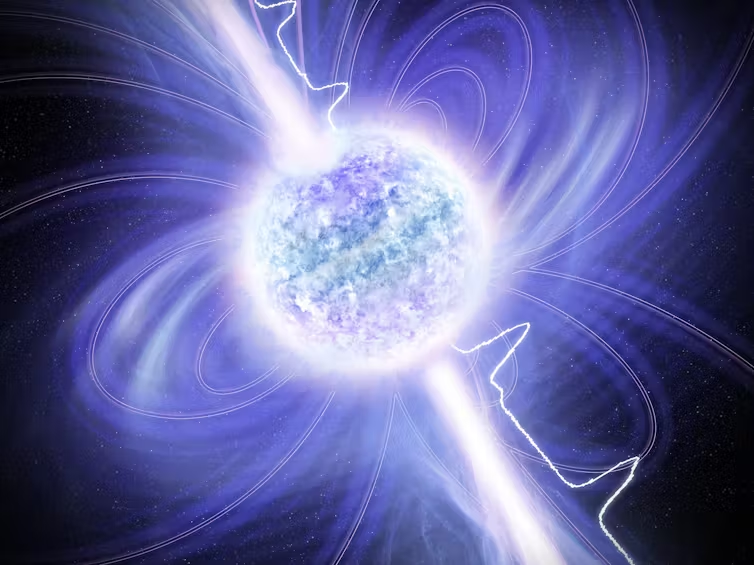Astronomers Find Unusual Slow-Spinning Radio Source That ‘Shouldn’t Exist’

At the end of their lifecycles, some of the largest stars explode in massive supernovas, leaving behind dense cores called neutron stars. These remnants can emit strong radio waves from their magnetic poles.
As these stars rotate, their radio beams sweep across Earth, creating periodic pulses much like a cosmic lighthouse. These stars are known as “pulsars.”
Pulsars generally spin at incredible speeds, completing full rotations in just seconds, or even less. However, in recent years, astronomers have detected a few objects emitting periodic radio pulses at much slower intervals, which challenges our understanding of neutron stars.
A recent study has revealed the slowest cosmic lighthouse so far, with a rotation period of 6.5 hours. This finding, published in Nature Astronomy, stretches the limits of what scientists believed was possible.
This slow “lighthouse” is aligned in such a way that we can observe radio pulses from both of its magnetic poles, a phenomenon not previously seen in slowly spinning objects, offering new insights into their behavior.
An Object That Shouldn’t Exist?
The object, named ASKAP J1839-0756, was discovered using CSIRO’s ASKAP radio telescope in Western Australia. During routine observations, the source stood out because it didn’t correspond to any known object in the region. Its radio emission showed an unusual fading burst, with its brightness decreasing by 95% in just 15 minutes.
Initially, researchers had no idea the source was emitting periodic pulses, as only one burst was detected at first. Further observations with ASKAP, the Australia Telescope Compact Array, and the MeerKAT radio telescope eventually confirmed the presence of two pulses spaced 6.5 hours apart.
But here’s the big surprise: ASKAP J1839-0756 shouldn’t exist based on what we know about neutron stars.
Neutron stars emit radio pulses by converting their rotational energy into radiation, gradually slowing down over time. The standard theory predicts that once their rotation slows to about one rotation per minute, they will stop emitting radio pulses. However, ASKAP J1839-0756 is defying this, emitting pulses at a leisurely pace of one rotation every 6.5 hours.

A Tale of Two Poles
Most pulsars, faster-spinning cousins of ASKAP J1839-0756, act like one-sided flashlights. Their rotational and magnetic axes are closely aligned, meaning we can only observe pulses from one magnetic pole.
However, in about 3% of pulsars, the axes are nearly perpendicular, allowing us to see pulses from both poles. These “interpulses” provide valuable insights into the star’s structure and magnetic field.
The behavior of the magnetic and rotational axes as pulsars slow down remains a mystery. The interpulse from ASKAP J1839-0756 offers clues to this unanswered question. Around 3.2 hours after the main pulse, the object emits a weaker, different pulse, suggesting we are observing radio waves from the opposite magnetic pole.
ASKAP J1839-0756 is the first slow-spinning object in its class to emit interpulses, raising important questions about how these objects function.
Magnetar or Something Else?
What powers this unusual object? One possibility is that it’s a magnetar—a neutron star with an incredibly strong magnetic field. Magnetars generate radio pulses differently, which might allow them to emit pulses even at slower spin rates. But even magnetars have limitations, with their periods typically measured in seconds, not hours.
The only exception is magnetar 1E 161348-5055, which has a period of 6.67 hours, but it only emits X-rays, not radio pulses.
Could ASKAP J1839-0756 be something else entirely? Some astronomers wonder if it could be a white dwarf—the remnant of a less massive star. White dwarfs rotate much slower than neutron stars, but isolated white dwarfs have never been observed emitting radio pulses. Furthermore, no other wavelengths have shown any evidence of a white dwarf at this location.
A Cosmic Puzzle
Whatever ASKAP J1839-0756 turns out to be, it’s clear this object is challenging our understanding. Its combination of slow rotation, radio pulses, and interpulses is forcing astronomers to reconsider the limits of neutron star behavior and explore new possibilities.
The discovery of ASKAP J1839-0756 serves as a reminder that the universe often surprises us, especially when we think we understand it completely. As we continue to study this mysterious object, we’re bound to uncover more secrets.
Read the original article on: Science Alert
Read more: Astronomers Witness the First Activation of a Supermassive Black Hole










